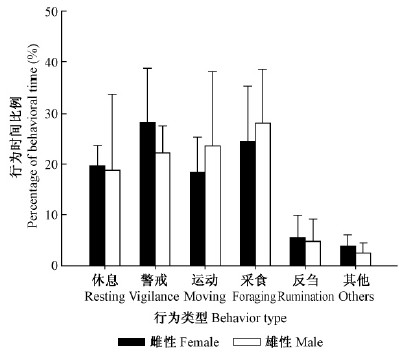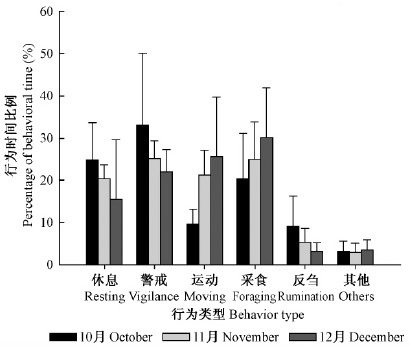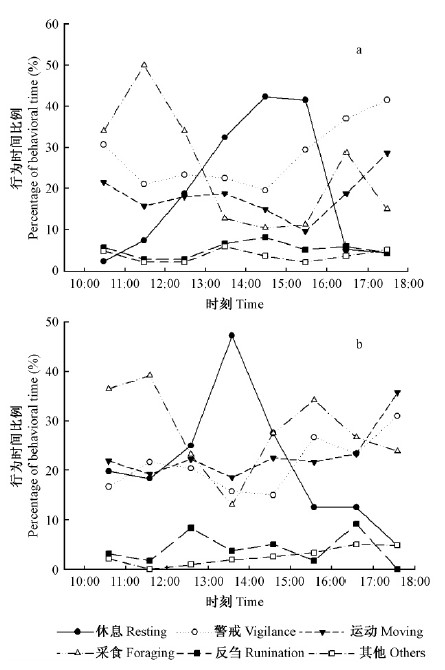文章信息
- 薛亚东, 孙志成, 吴鹏, 张于光, 李迪强
- Xue Yadong, Sun Zhicheng, Wu Peng, Zhang Yuguang, Li Diqiang
- 散养条件下野生双峰驼初冬活动时间分配及节律
- Time Budgets and Diurnal Activity Rhythms of Re-Introduced Wild Bactrian Camels in Semi-Free Environment during Early Winter
- 林业科学, 2015, 51(2): 169-174
- Scientia Silvae Sinicae, 2015, 51(2): 169-174.
- DOI: 10.11707/j.1001-7488.20150221
-
文章历史
- 收稿日期:2013-11-15
- 修回日期:2014-05-28
-
作者相关文章
2. 甘肃敦煌西湖国家级自然保护区管理局 敦煌 736299;
3. 西南林业大学竹藤研究所 昆明 650224
2. Administrative Bureau of Gansu Dunhuang Wetland National Nature Reserve Dunhuang 736299;
3. Institute of Bamboos, Southwest Forestry University Kunming 650224
动物的行为时间分配与活动节律是动物行为生态学研究中的一项重要内容(Alderman et al.,1989; Zeller,1997; Vasconcelos et al.,2012),行为时间分配的变化和活动节律的形成是动物对各种生物因素和非生物因素变化综合适应的结果(Morgan,2004)。荒漠地区动物的行为多受高温、缺水等极端环境条件的影响,表现出与自然条件相适应的规律,多数有蹄类动物随日间气温的升高活动减少,存在晨昏活动模式(Mccutchen,1984; Giotto et al.,2013)。
野生双峰驼(Camelus ferus)(以下简称野骆驼)是亚洲中部对极端干旱环境具有高度适应性的动物,现存种群数量不足 1 000峰,其中,中国大约有600峰,蒙古国大约有350峰,孤立分布在中国的塔克拉玛干沙漠东部、罗布泊北部嘎顺戈壁、阿尔金山北麓及阿奇克谷地以及中蒙边境的外阿尔泰戈壁等地区(Tulgat et al., 1992; Hare,2008; NatureServe et al., 2012)。野骆驼属于我国Ⅰ级保护动物,被IUCN列为极度濒危物种。 野骆驼生性机警且在荒漠半荒漠地区分布,因此其生态学研究一直较为缺乏,目前,尚未见其行为时间分配和活动节律方面的研究报道。2012年9月,甘肃武威濒危动物研究中心和敦煌西湖国家级自然保护区联合进行了圈养野骆驼的试验性放归。由于野外研究的困难,通过对散养状态下野骆驼昼间行为时间分配及活动规律的研究,将有助于丰富野骆驼行为生态学基础资料。同时放归区西湖湿地是野骆驼的一个重要分布区,试验性放归生境与自然生境一致,使本研究更具参考意义,并能为野骆驼进一步保护和管理提供借鉴。
1 研究区概况与研究对象甘肃敦煌西湖国家级自然保护区地处甘肃河西走廊最西端,西临库姆塔格沙漠和罗布泊,南接阿克塞哈萨克族自治县,北连新疆维吾尔自治区,地理坐标为39°45′—40°36′N,92°45′—93°50′E,总面积66万hm2。该区域是内陆干旱地区的典型湿地,区内芦苇(Phragmites australis)、多枝柽柳(Tamarix ramosissima)和胡杨(Populus euphratica)为绝对优势种,苏枸杞(Lycium ruthenicum)、疏叶骆驼刺(Alhagi sparsifolia)和胀果甘草(Glycyrrhiza inflata)为主要伴生种(陈文业等,2012)。观察期间试验性放归的野骆驼散放于敦煌西湖国家级自然保护区玉门关保护站的围栏内,围栏生境面积为22 km2。
研究对象为4峰已成年的野骆驼,于2012年9月6日试验性放归。2峰雄性野骆驼于出生时从野外救助得到,先前圈养于敦煌西湖国家级自然保护区玉门关保护站小围栏内,取名敦敦和煌煌;2峰雌性野骆驼来自武威濒危动物研究中心,为第1代繁育个体,取名武武和威威。4峰骆驼均有明显特征,可以被观察人员辨识。
2 研究方法 2.1 行为谱构建及观察方法2012年9月30日—10月3日进行预观察,参照有蹄类相关文献构建行为谱(蒋志刚,2000;刘振生等,2005;夏参军等,2009;吉晟男等,2013)。将野骆驼的行为分为6类: 1)休息——侧卧或跪卧在地面上,眼睛睁开、半闭或闭上; 2)警戒——站立并注视一定方向; 3)运动——包括走动、奔跑和跳跃; 4)采食——站立或行走状态下,头部低于肩部水平线,具有觅食意图或动作; 5)反刍——对食物进行逆呕、咀嚼、吞咽等,可观察到食物在食道中上下运动; 6)其他——包括排遗、调温(荒漠和沙漠动物对于高温所做出的一系列对自身体温进行调节的行为)、发情、交配、冲突、亲和、通讯、聚群等。
由于研究区域地处荒漠,交通和生活不便,结合实际巡护情况,2012年10月3日后每周随机观察2天,只进行昼间行为的观察,观察时间为10:00—18:00(北京时间)。观察前记录日期、时间、地理坐标、天气状况、观察对象以及观察者与观察对象的距离。经过管护人员的日常观测和巡护,散养野骆驼已适应了人员观察。采用目标动物取样法,借助双筒望远镜,采用5 min时间间隔的瞬时扫描取样法,记录当时野骆驼的行为。
2.2 数据分析截至2012年12月28日,去除1天中观测不完整的天数,共对雌性野骆驼进行了11天(88 h)的观察,雄性野骆驼进行了9天(72 h)的观察。其中,10月观察时间为32 h,11月观察时间为64 h,12月观察时间为64 h。按性别和月份分别统计各行为出现的频次和百分比。数据分析前,都先采用单样本K-S 检验方法(One-sample Kolmogorov-Smirnov test)进行数据的正态性检验。采用Mann-Whitney U检验分析不同性别间行为时间分配差异,采用Kruskal-Wallis H 检验分析各行为时间分配和活动节律差异。所有统计分析均使用SPSS 19.0软件完成。P < 0.05 为差异显著,文中数值均为平均值±标准差。
3 结果与分析 3.1 野骆驼昼间行为时间分配观察期间,雌性野骆驼昼间警戒行为所占比例要高于其他行为,为 28.22%±10.74%,其次是采食 24.47%±10.92%,休息 19.68%±4.06%,运动 18.29%±7.14%,反刍和其他行为比例最低,分别为 5.48%±4.44%和3.86%±2.26%(图 1)。Kruskal-Wallis H 检验结果表明,6种行为时间分配存在极显著差异(P < 0.01)。
 |
图 1 不同性别野骆驼行为时间分配 Fig. 1 Behavioral time budget of male and female wild camels |
雄性野骆驼昼间采食行为所占时间要高于其他行为,为 28.13%±10.42%,其次是运动 23.63%±14.47%、警戒 22.15%±5.46%、休息 18.84%±14.96%,反刍和其他行为比例最低,分别为 4.79%±4.45%和2.46%±1.98%(图 1)。Kruskal-Wallis H 检验结果表明,6种行为时间分配存在极显著差异(P < 0.01)。
Mann-Whitney U检验表明,观察期内雌性野骆驼与雄性野骆驼用于休息、警戒、运动、采食、反刍和其他行为在时间分配比例上均无显著差异(P>0.01)。
从野骆驼休息行为来看,10月所占比例为 24.81%±8.86%,11月为 20.36%±3.27%,12月为 15.49%±14.16%;从警戒行为来看,10月所占百分比为 33.07%±17.06%,11月为 25.17%±4.16%,12月为 22.01%±5.30%;从反刍行为来看,10月所占比例为 9.00%±7.27%,11月为 5.30%±3.30%,12月为 3.13%±2.08%(图 2)。随月份变化休息时间、警戒时间和反刍时间呈下降趋势。 从野骆驼运动行为来看,10月所占比例为 9.64%±3.47%,11月为 21.27%±5.80%,12月为 25.65%±13.97%,;从采食行为来看,10月所占比例为 20.35%±10.75%,11月为 24.91%±8.86%,12月为 30.21%±11.67%(图 2)。随月份变化运动时间和采食时间呈上升趋势。
 |
图 2 不同月份野骆驼行为时间分配 Fig. 2 Behavioral time budget of wild camels during October, November and December |
从野骆驼其他行为来看,10月所占比例为 3.13%±2.54%,11月为 2.99%±2.07%,12月为 3.52%±2.42%,无明显变化趋势(图 2)。
Kruskal-Wallis H检验结果表明,不同月份野骆驼的休息和运动行为时间分配存在显著差异(P < 0.05),而警戒、采食、反刍和其他行为时间不存在显著差异(P >0.05)。
3.2 野骆驼昼间活动节律以小时为时间段,10:00—18:00间野骆驼的活动节律如图 3所示。野骆驼的休息行为均存在一个高峰,雌性的高峰出现在 14:00—15:00,雄性的高峰出现在 13:00—14:00。雌雄野骆驼的采食行为均表现出明显的双峰格局,雌性野骆驼的采食行为高峰出现在 11:00—12:00和16:00—17:00;雄性的采食行为高峰出现在 11:00—12:00和15:00—16:00。雌性野骆驼的警戒和运动行为的高峰均出现在 10:00—11:00和17:00—18:00。雄性野骆驼的警戒行为和运动行为的高峰均出现在 17:00—18:00,10:00—11:00,后者的高峰则不如雌性明显。
 |
图 3 野骆驼昼间活动节律 Fig. 3 Diurnal behavioral rhythms of wild camels a.雌性Femal;b.雄性Male. |
Kruskal-Wallis H 检验结果显示,雌性野骆驼昼间各时间段休息、警戒和采食行为时间分配存在显著差异(P < 0.05),运动、反刍和其他行为时间分配均无显著差异(P > 0.05)。雄性野骆驼昼间各时间段行为时间分配均无显著差异(P > 0.05)。
4 讨论 4.1 行为时间分配动物的行为时间分配是对特定环境特定季节能量平衡策略的表现。圈养状态下马麝 (Moschus sifanicus)(孟秀祥等,2007)、马鹿 (Cervus elaphus alxaicus)(李志军等,2008)等有蹄类将最多的时间分配给休息行为,而本研究中的野骆驼处于散养状态下,更接近野外条件,所以表现出与野外动物近似的时间分配策略,将最多的时间用于采食(雌性野骆驼采食行为时间仅次于警戒行为)。散养状态下的梅花鹿 (C.nippon) 也表现出同样的行为时间分配策略(刘振生等,2002)。冬季贺兰山岩羊 (Pseudois nayaur) 一天中取食行为所占时间达到60%以上(刘振生等,2005),冬季雌性鹅喉羚 (Gazella subgutturosa) 的采食时间高达68%,雄性也达到了29.6%(夏参军等,2009),与其相比,雌性和雄性野骆驼昼间采食行为所占时间均未超过30%。这主要是因为在冬季食物匮乏的情况下,保护站为野骆驼提供了以苜蓿(Melissilus ruthenicus)为主的干草料,以及玉米(Zea mays)、黑豆(Glycine max)等精饲料,使野骆驼摄入了充足的能量,从而使野骆驼能将较多时间分配给其他行为。
雄性野骆驼警戒、休息和运动行为时间分配较为平均,均占到昼间活动时间的20%左右。由于雌性野骆驼来自甘肃武威濒危动物研究中心,对陌生环境有一个适应的过程,因此放归初期将最多的时间用于警戒,用于采食、运动和休息的行为也较为平均。性别对有蹄类活动时间分配的影响一般因特定的物种和生理发育期而有所差异(刘振生等,2005;孟秀祥等,2007;刘丙万等,2009;夏参军等,2009;吉晟男等,2013),雌性与雄性野骆驼用于休息、警戒、运动、采食、反刍和其他行为在时间分配比例上均无显著差异,但由于野骆驼于11月进入发情期,相比其他行为,雄性野骆驼的运动行为所占比例(23.63%)要高于雌性野骆驼(18.29%)。 4.2 昼间活动节律动物行为的活动节律受气温、湿度、昼长等非生物因素和性别、繁殖、社群等生物因素的影响,影响不同动物活动节律的主导因素不同(孟秀祥等,2002;刘昊等,2004;李明富等,2011)。干旱、半干旱地区有蹄类动物的活动节律多受温度和降水影响(Leslie et al., 1979)。大多数有蹄类具有晨昏活动的行为节律,觅食活动高峰期出现在日出和日落前后,普氏原羚 (Procapra przewalskii)(李迪强等,1999)、 天山盘羊 (Ovis ammon)(郭松涛等,2003)、藏原羚 (Procapra picticaudata)(连新明等,2012)都有晨昏取食的高峰期。马麝(孟秀祥等,2002)、黑麂 (Muntiacus crinifrons)(章书声等,2012)等的日活动高峰同当地的季节性日出和日落时间有极大的吻合。与大多数有蹄类一样,野骆驼采食行为也存在 2个高峰,由于研究区位于甘肃新疆交界地区,与北京有将近2 h的时差,所以换算成当地时间,其采食高峰也接近当地冬季的日出和日落时间;但由于冬季气温较低,为避开日出和日落时的低温,野骆驼的采食行为也做出了相应的调整和适应,其高峰时段出现在日出之后(9:00—10:00)和日落之前(14:00—16:00),这与冬季鹅喉羚的采食行为(夏参军等,2009)类似。野骆驼的警戒和运动行为,往往伴随着其采食行为,其高峰出现在一天开始至采食高峰之前的时段,以及一天结束、采食高峰活动后,表现出晨昏活动的高峰。而野骆驼的休息高峰出现在中午时分(11:00—13:00),呈现出单峰格局,这与野骆驼行为时间分配策略是相符的。
总体上看,散养条件下野骆驼行为时间分配和活动节律表现出与大多数有蹄类类似的策略,包括时间分配上采食行为时间比例较高、存在晨昏活动高峰等。随时间的推移,野骆驼对放归生境逐步适应,因此表现出休息、警戒时间下降的趋势,而随着冬季气温的降低,野骆驼为获取能量,表现出运动时间和采食时间上升的趋势。由于观测地区野外环境和观测条件的限制,本研究的样本量较少,观察结果可能存在一定的误差,今后将采用更加全面的观测方法,对野骆驼行为谱及PAE编码系统进行研究。随着放归野骆驼的繁殖及生育,其他季节野骆驼行为时间分配与活动节律的变化以及季节差异,包括性别、年龄以及带羔的影响,需要进一步观察研究。
| [1] |
陈文业, 张继强, 赵 明, 等.2012.甘肃敦煌西湖荒漠-湿地植物群落物种多样性特征研究.中国沙漠, 32(6): 1639-1646. (Chen W Y, Zhang J Q, Zhao M, et al. 2012. Species diversity characteristics of plant community in Xihu desert wetland of Dunhuang, Gansu Province. Journal of Desert Research, 32(6): 1639-1646.[in Chinese])(  1) 1)
|
| [2] |
郭松涛, 余育群, 李保国, 等.2003.天山盘羊秋季集群习性和日活动节律初步观察.兽类学报, 23(1):27-30. (Guo S T, Yu Y Q, Li B G, et al. 2003. Study on herb structure and daytime activity rhythm of argali (Ovis ammon karelini) in autumn of Tianshan. Acta Theriologica Sinica, 23(1): 27-30[in Chinese]).(  1) 1)
|
| [3] |
吉晟男, 杨亮亮, 葛兴芳, 等.2013.圈养普氏野马夏季高温期昼间活动时间分配研究.四川动物, 32(5):676-683. (Ji S N, Yang L L, Ge X F, et al. 2013. Diurnal activity time budget of the captive Equus ferus przewalskii in high temperature period of summer. Sichuan Journal of Zoology, 32(5): 676-683[in Chinese]).(  2) 2)
|
| [4] |
蒋志刚.2000.麇鹿行为谱及PAE编码系统.兽类学报, 20(1):1-12. (Jiang Z G. 2000. Behavior coding andethogram of the pere David's deer. Acta Theriologica Sinica, 20(1): 1-12[in Chinese]).(  1) 1)
|
| [5] |
李迪强, 蒋志刚, 王祖望.1999.普氏原羚的活动规律与生境选择.兽类学报, 19(1):17-24. (Li D Q, Jiang Z G, Wang Z W. 1999. Activity patterns and habitat selection of thePrzewalskis gazelle (Procapra przewalskii) in the Qinghai lake region. Acta Theriologica Sinica, 19(1): 17-24[in Chinese]).(  1) 1)
|
| [6] |
李明富, 李晟, 王大军, 等.2011.四川唐家河自然保护区扭角羚冬春季日活动模式研究.四川动物, 30(6): 850-855. (Li M F, Li S, Wang D J, et al. 2011. The daily activity pattern of takin Budorcas taxicolor in winter and spring at Tangjiahe Nature Reserve, Sichuan Province. Sichuan Journal of Zoology, 30(6): 850-855[in Chinese]).(  1) 1)
|
| [7] |
李志军, 刘尊显.2008.圈养马鹿阿拉善亚种冬季昼间行为及活动规律.野生动物杂志, 29(2):59-62. (Li Z J, Liu Z X. 2008.Diurnal behavior of red deer subspecies alxaicus in captivity in winter. Chinese Journal of Wildlife, 29(2): 59-62[in Chinese]).(  1) 1)
|
| [8] |
连新明, 李晓晓, 颜培实, 等.2012.夏季可可西里雌性藏原羚行为时间分配及活动节律.生态学报, 32(3): 663-670. (Lian X M, Li X X, Yan P S, et al. 2012. Behavioural time budgets and diurnal rhythms of the female Tibetan gazelles in the Kekexili National Nature Reserve. Acta Ecologica Sinica, 32(3): 663-670[in Chinese]).(  1) 1)
|
| [9] |
刘丙万, 钱执强, 张博, 等.2009.内蒙古达赉湖地区蒙原羚繁殖期及其前后昼间行为时间分配及能量平衡策略.动物学研究, 30(6):694-698. (Liu B W, Qian Z Q, Zhang B, et al. 2009. Diurnal activity budgets and energy balance strategy of Mongolian gazelle (Procapra gutturosa) before, during and after the rut around Dalai Lake, Inner Mongolia. Zoological Research, 30(6): 694-698[in Chinese]).(  1) 1)
|
| [10] |
刘昊, 石红艳, 胡锦矗.2004.四川梅花鹿春季昼夜活动节律与时间分配.兽类学报, 24(4):282-285. (Liu H, Shi H Y, Hu J C. 2004. Daily activity rhythm and time budget of Sichuan sika deer (Crvus nippon sichuanicus) in spring. Acta Theriologica Sinica, 24(4): 282-285[in Chinese]).(  1) 1)
|
| [11] |
刘振生, 吴建平, 滕丽微.2002.散放条件下春季梅花鹿行为时间分配的研究.生态学杂志, 21(6):29-32. (Liu Z S, Wu J P, Teng L W. 2002. Time budget and behavior pattern of semi-free Cervus nippon in spring. Chinese Journal of Ecology, 21(6): 29-32[in Chinese]).(  1) 1)
|
| [12] |
刘振生, 王小明, 李志刚, 等.2005.贺兰山岩羊不同年龄和性别昼间时间分配的季节差异.动物学研究, 26(4):350-357. (Liu Z S, Wang X M, Li Z G, et al. 2005. Seasonal variation of diurnal activity budgets by blue sheep (Pseudois nayaur) with different age-sex classes in Helan mountain. Zoological Research, 26(4): 350-357[in Chinese]).(  3) 3)
|
| [13] |
孟秀祥, 杨奇森, 冯祚建, 等.2002.圈养马麝夏秋冬活动格局的比较.兽类学报, 22(2):87-97. (Meng X X, Yang Q S, Feng Z J, et al. 2002. Preliminary studies on active patterns during summer, autumn and winter in captive alpine musk deer. Acta Theriologica Sinica, 22(2): 87-97[in Chinese]).(  2) 2)
|
| [14] |
孟秀祥, 杨奇森, 冯祚建, 等.2007.圈养马麝非繁殖季节行为特征及行为节律的性别间差异.应用与环境生物学报, 13(3):349-352. (Meng X X, Yang Q S, Feng Z J, et al. 2007. Behavioral characteristics of captive alpine musk deer during non-mating season. Chinese Journal of Applied Environmental Biology, 13(3): 349-352[in Chinese]).(  2) 2)
|
| [15] |
夏参军, 乔建芳, 杨维康, 等.2009.冬季鹅喉羚昼间行为时间分配及活动节律.生态学杂志, 28(2):283-287. (Xia C J, Qiao J F, Yang W K, et al. 2009. Diurnal behaviors time budgets and activity rhythms of Gazella subgutturosa in winter.Chinese Journal of Ecology, 28(2):283-287[in Chinese]).(  4) 4)
|
| [16] |
章书声, 鲍毅新, 王艳妮, 等.2012.基于红外相机技术的黑麂活动节律.兽类学报, 32(4):368-372. (Zhang S S, Bao Y X, Wang Y N, et al. 2012. Activity rhythms of black muntjac (Muntiacus crinifron) revealed with infrared camera. Acta Theriologica Sinica, 32(4): 368-372[in Chinese]).(  1) 1)
|
| [17] |
Alderman J A, Krausman P R, Leopold B D. 1989. Diel activity of female desert bighorn sheep in western Arizona. The Journal of Wildlife Management, 53: 264-271.( 1) 1)
|
| [18] |
Giotto N, Picot D, Maublanc M L, et al. 2013. Effects of seasonal heat on the activity rhythm, habitat use, and space use of the beira antelope in southern Djibouti. Journal of Arid Environments, 89: 5-12.( 1) 1)
|
| [19] |
Hare J. 2008. Camelus ferus. The IUCN Red List of Threatened Species. Version 2012.2. .www.iucnredlist.org.( 1) 1)
|
| [20] |
Leslie Jr D M, Douglas C L. 1979. Desert bighorn sheep of the River Mountains, Nevada. Wildlife Monographs, 66.( 1) 1)
|
| [21] |
Mccutchen H E. 1984. Summer activity patterns of free-ranging desert bighorns, Zion National Park, Utah. Desert Bighorn Council Transactions, 28:9-11.( 1) 1)
|
| [22] |
Morgan E. 2004. Ecological signicance of biological clocks. Biological Rhythm Research, 35: 3-12.( 1) 1)
|
| [23] |
NatureServe, IUCN. 2012. Camelus ferus.IUCN Red List of Threatened Species. Version 2012. .http://www.iucnredlist.org.( 1) 1)
|
| [24] |
Tulgat R, Schaller G B. 1992. Status and distribution of wild Bactrian camels (Camelus bactrianus ferus). Biological Conservation, 62(1):11-19. ( 1) 1)
|
| [25] |
Vasconcelos R, Santos X, Carretero M A. 2012. High temperatures constrain microhabitat selection and activity patterns of the insular Cape Verde wall gecko. Journal of Arid Environments, 81:18-25.( 1) 1)
|
| [26] |
Zeller D C. 1997. Home range and activity patterns of the coral trout Plectropomus leopardus (Serranidae). Marine Ecology Progress Series, 154: 65-77.( 1) 1)
|
 2015, Vol. 51
2015, Vol. 51

